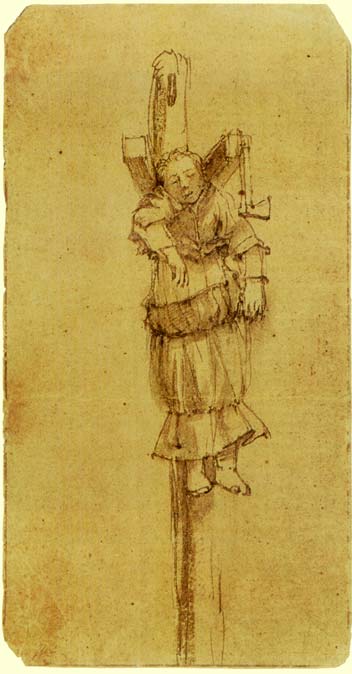 |
Rembrandt Harmensz. van Rijn 1606 – 1669 Elsje Christiaenstwo drawings with pen and brush (17 × 9 cm) — 1664
Rate this work of art: |
Elsje Christiaens was 18 years old when she left her home in Denmark to start a new life in booming Amsterdam in 1664. Like many others, she wanted to make a living as a maid. She found a room in a boarding house on the Damrak. After two weeks Elsje still hadn't found a job, and the landlady started pressing her to pay. The next morning the woman repeated her demand, threatened to take Elsje's few possessions, and began beating her with a broom. Elsje lost control, grabbed an axe that was lying around, and struck the landlady with it. The woman fell into the cellar and lay dead. On hearing the noise, neighbours came to find out what was going on. Elsje panicked and fled outside, where she jumped into the water of the Damrak. Bystanders helped her out of the water. She was brought before the city magistrates, who questioned her and sentenced her to death. The city executioner strangled her in public outside the town hall on Dam's Square. Her body was hung on a pole in the Volewijk, a field on the northern shore of the IJ, where all condemned were put on display to deter others. The axe was hung next to her head. |
In 1664 Rembrandt was almost sixty. His second wife had died, he was in financial strait, living in a very modest house on the Rozengracht. When he heard of Elsje Christiaen's fate he had himself rowed to the Volewijk on the very day of her death. The old master made two sober drawings of her: one in profile and one full-face. The innocent face is extraordinarily striking, showing disbelief as well as resignation. An interesting detail is that art historians used to date the drawings around 1655 on stylistic grounds, but never bothered to actually check the trial date in the city records. The records left no doubt that the drawings must have been made in 1664. This work is officially known as A Woman Hanging On a Gibbet. |
 Metropolitan Museum of Art, New York
Metropolitan Museum of Art, New York